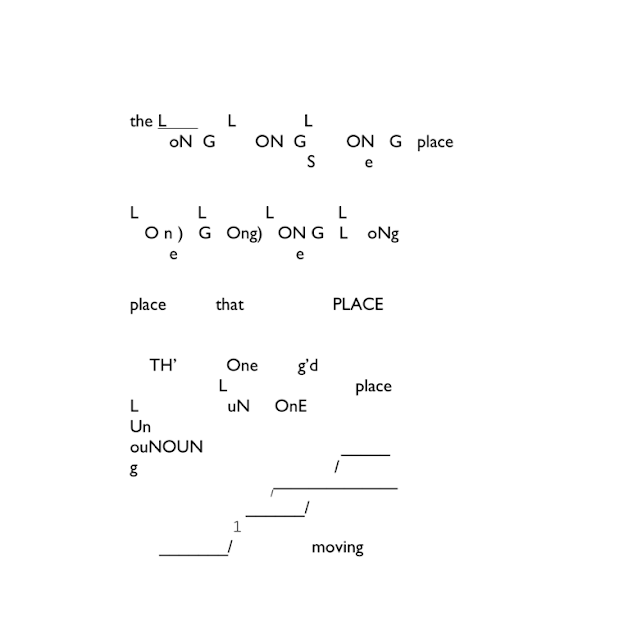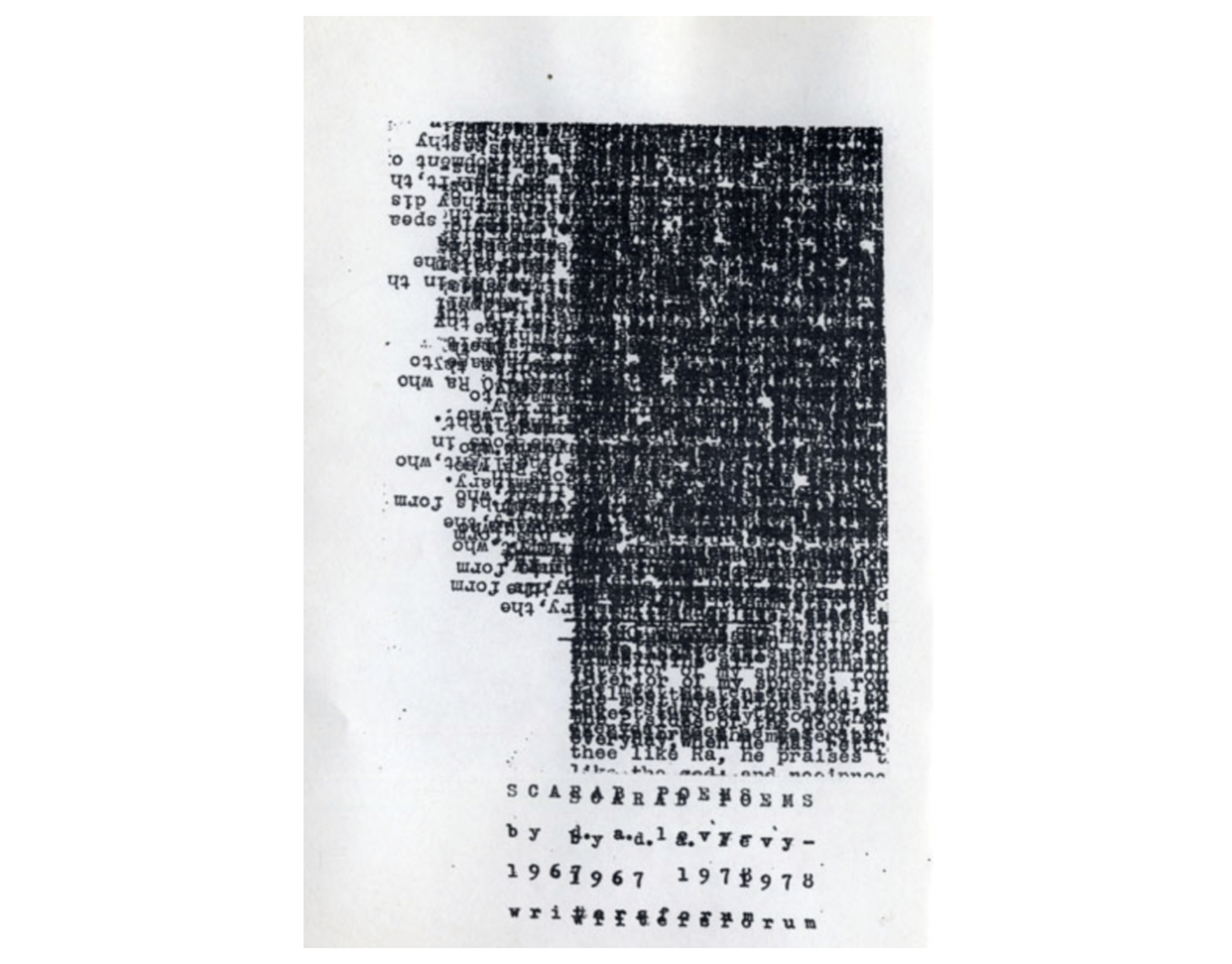CLEVELAND CONCRETE: Russell Atkins, d.a. levy, & the Roots of American Concrete Poetry
Russell Atkins, from “A Podium Presentation”
The following is excerpted from the introductory section of the article, “Cleveland Concrete.” Its full contents with footnotes may be found at Synapse International. Thanks to the CSU Poetry Center.
—Karl Kempton, Oceano, CA
This article brings to light a group of individuals in Cleveland, Ohio out of which came the first American anthology of concrete poetry, cleveland concrete, in 1966. By American I mean American-published and American-only concrete poets. All other American-published anthologies of that period were internationally edited and thus international concrete poets dominated, including only a few Americans. Only Jean-Francois Bory’s anthology Once Again (1968) from New Directions contained more than the usuals. Of the Cleveland concrete poets, d.a. levy is best known and in some circles a major figure whose story in concrete poetics remains to be fully researched and illuminated.
This stature and thus the long cast of his shadow unfortunately has hidden the others of Cleveland, lexical and concrete poets, in varying degrees for various reasons, none of which are for me excusable. One of several omissions is that d.a. levy published many individuals’ first books of concrete poetry, most prior to 1967. His voluminous national and international correspondence and mailings of publications to international and national concrete poets shifts the question mark from ? to
?
afloat in this void of obvious omissions seen in the anthologies and commentaries. Only one poem of levy’s appeared in these anthologies—in New Directions’ Bory anthology.
Cover of d.a. levy’s Scarab
Russell Atkins wrote / composed and published lexical-sound poem objects years before Concrete Poetry was formed as a movement. Of the many fields of his polymath life of creativity, music and poetry were primary and undifferentiated. During the last decade academia has illuminated a few of his lexical-sound objects. Craig Dworkin’s Eclipse archive gathered and continues to gather his works. Two books provide poems, including surviving pre- and concrete-like era poems, music, and Atkins’ important “A Psychovisual Perspective for ‘Musical’ Composition” initially published in his Free Lance magazine in 1955. This manifesto I think, feel, and see may be applied as a frame for his visual poetic. Academia has not, as yet, provided a context for Atkins within the concrete poets of Cleveland, nationally, or internationally.
CLEVELAND
It's little-known that the first American concrete poetry anthology is the cleveland concrete anthology, published by rjs in 1966. Instead, most point to Emmett Williams’ Concrete Poetry Anthology (1967). Here is a list of concrete poetry anthologies published in the States after 1966: The Chicago Review Anthology of Concretism, edited by Eugene Wildman, 1967; Concrete Poetry An International Anthology, edited by Stephen Bann (Beloit Journal), 1967; An Anthology of Concrete Poetry, Something Else Press, edited by Emmett Williams, 1967; Once Again, New Directions, edited by Jean-Francois Bory 1968; and Concrete Poetry: A World View, Bloomington: Indiana University Press, edited by Mary Ellen Solt, 1970. All are internationally dominated, with few Americans. No one from Cleveland appears or is mentioned in any concrete poetry anthology except levy in the Bory anthology. And the highest treason of all—no mention of Youngstown, Ohio-born Kenneth Patchen, who during the 40s wrote a number of poetic novels, some dense with a new American typographical imagery forecasting the coming of concrete poetry and most of its forms. levy’s appearance in Bory’s Once Again seems traceable to the 1966 concrete poetry exhibition in Paris in which works by levy and d.r. wagner were displayed.
The Great Lakes are the American and Canadian fourth coasts. Cleveland from the end of 1964 to the late 60s was the center of American and Canadian concrete. Another American pre-concrete poet with roots in concrete and electronic music, polymath Russell Atkins, still lives in Cleveland. Before concrete poetry was a formal visual poetic, he had published in the late 40s and early 50s a handful of pre-concrete poems (composed on a typewriter), and a manifesto on music, with important concepts. One such idea is that sound is a sculptural object visible to the mind’s eye. His manifesto is not a theoretical possibility. Before writing it his pre-concrete era poems, which are seen objects, were published. He mentored d. a. levy and Kent Taylor who in turn mentored RJS, Tom Kryss and others. From what they learned from Atkins, levy and Taylor added much more from concrete poetry magazines available in the now famous but gone Asphodel Bookstore run by Jim Lowell. levy published many American and Canadian concrete poets’ first books. He died in 1968 by suicide. A minority report suggests death by police assassination which provides a foreshadowing of the dark political and racial shadow over Cleveland during this era. The American-Canadian center of gravity soon shifted to Toronto and eventually other centers of visual poetics formed in part because of Canadian government support of arts and literature.
. . .
levy often has been called the (capital P) Poet of Cleveland. Not to discount this opinion, I suggest examining the works by his mentor, Russell Atkins. Atkins was not influenced by Beat literature and not inclined to write in the form of the long poem, except his drama poetry. Atkins did not drive. He walked the city. As did levy. It appears Atkins was often awake most of the night, not getting up until after noon. As mentioned above he keenly observed, being a musician, the sounds of Cleveland. After “seeing his sound-object,” then the poem written-composed arrived with his unique blending of image-object-projection woven with his particular cultural insights. When publishers manifest a series of publications the choice of its first voice is not taken lightly. I am certain, given my feel for levy and the sharing by Kent Taylor, levy was no exception. Thus, Distant the Sound by Atkins as the first of the 1965 chapbook series seems to suggest gratitude for his mentoring and an acknowledgment of Atkins’ role in concrete poetry before there was concrete poetry as a type of poetic expression. Added to this kinetic sound poem of drifting voices of a choir ensemble is “A STORM SHALL BREAK” (see below). The latter may be the most lyrical and lace-like in the concrete anthology issue; it captures the movement of a tree in the flash and sound of a coming storm. Atkins, as I read him, being the poet of the place of Cleveland before levy and Taylor, remains keener than most poets in expressing the sounds of place, especially in his dexterity. His skilled use of visual gestures within language are honed first from what he learned and then harnessed from the avant-garde and then registered into his own voice. His mind’s eye sees the sculpt object in its initial sound form and then shows the drift as it bounces along, off and over the walls of his beloved city, from which he too never moved away.
Russel Atkins, “A Storm Shall Break”
. . .
In early 1963 Kent Taylor wandered into the newly opened Publix Book Mart. He had just returned to Cleveland when the call to poetry eclipsed medical school. There he found Free Lance, a small press magazine. Given the quality of poetry and numbers of established poets, without hesitation he assumed the independent small magazine came from New York. Surprise may be too understated of a word discovering it was published in Cleveland. The phone number for the co-editor/publisher began a series of events leading him into the flourishing local poetry scene and what evolved separately into the Cleveland concrete poetry expression. Unknown, however, Cleveland’s concrete had already been in motion more than a decade prior by the publisher-coeditor of the magazine and also the name of the Cleveland poetry workshop where Kent met d.a. levy through the graciousness of Russell Aktins, a graciousness Kent remembers fondly to this moment. Atkins I consider the foundation of Cleveland Concrete.
Kent’s surprise may or may not be larger than mine learning of Russell Atkins, another I’ll call a m.i.a., missing in action, among concrete and visual poetry “histories.” Of such “histories” often I have stated that they for me remain more lineage than history. Moreover, within the concrete poets of Cleveland, Atkins is not the only unmentioned. Mention concrete poetry of Cleveland, d.a. levy almost without exception will be named. All others, unless one is familiar with the literary underground of Cleveland during the 1960s into the early 70s, continue as unknowns or ignoreds. The first American anthology of concrete poetry remains essentially forgotten or ignored. A copy of it costs 900 dollars which I am unable to afford and thus ruminate on in detail or share examples. William’s 1967 anthology is available for 125 dollars, Ellen Solt’s Concrete Poetry, A World View, 100 dollars.
Russell Atkins, from “Nocturne & Prelude”
Karl Kempton lives with his beloved wife, Ruth, in Oceano, California. He is a poet, visual poet, editor, publisher, writer, photographer, curator, archaeo-astronomer, environmental activist, and retired organic with biodynamic nuance microgreen grower. Lexical and visual poems are widely exhibited and published nationally and internationally. Writings on visual poetry focus on actual history, not biased as most by group lineages disguised as history. Recent books include Intimate Hands: Selected B&W Poems, 1995-2013; sandskrit of the oceano dunes; and selected lexical & visual mathematical poetry 1976-2022. More information: https://www.karlkempton.net/.



